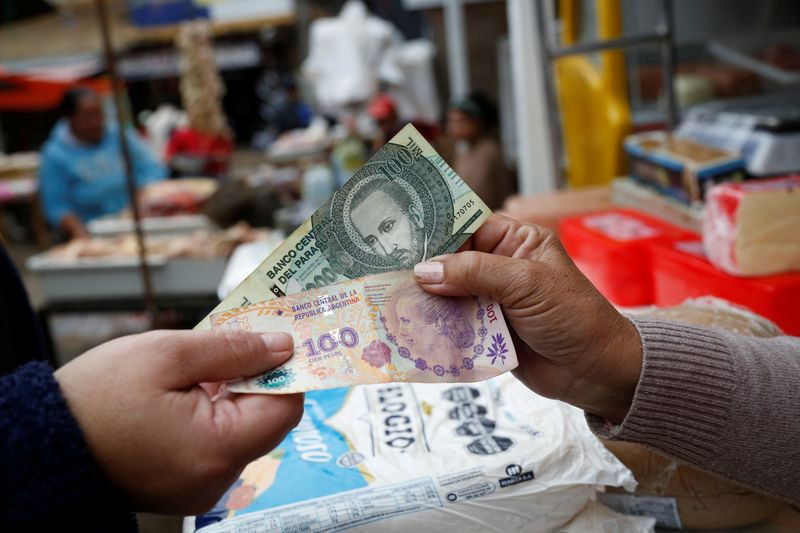By Daniela DeSantis and Lucinda Elliott
NANAVA, Paraguay (Reuters) – Paraguayan buyers used to flock to the border city of Nava to purchase low-cost imports from Argentina, however years of weak point within the peso foreign money have saved gasoline, medication and gasoline smuggled throughout the border at bay. Relative costs for groceries remained low.
Now, Nanava has change into a ghost city, fueled by Argentina’s uncommon inflation charge of almost 300% and a peso that’s buoyed even by a broadly used parallel market underneath liberal President Javier Milei. The trade charge in opposition to the U.S. greenback elevated, inflicting the value of contraband to rise sharply.
“Earlier than, the whole lot was going properly and we bought the whole lot,” stated Marta, 57, a pharmacy worker in Nanawa who solely needed to present her first title. “There’s nothing left now. We have been like this for 2 months and the city is lifeless.”
Store homeowners in Nanava, 30 kilometers (18 miles) from the capital Asunción, estimated to Reuters that gross sales had plunged 60-80% since Mire took workplace in December, when he sharply devalued the official peso foreign money and launched austerity measures .
Since then, the peso has depreciated by simply 2% per thirty days underneath a managed “crawling peg,” whereas month-to-month inflation, whereas slowing, is round 10-20% per thirty days. This implies costs in U.S. greenback phrases have surged.
On January 1, an merchandise price 1,000 pesos was price $1.24 at that day’s official trade charge. With the cumulative inflation charge in April at 65%, the identical product on April 30 value 1,650 pesos and was price $1.88, a rise of greater than 50%.
That makes Argentina’s foreign money costlier in relative phrases, prompting analysts to say the peso is overvalued and calls for an additional devaluation. On the similar time, vacationers and exporters are additionally feeling the strain of much less aggressive native costs.
“This course of is painful for Argentina,” stated Jimena Abreu, an economist at Uruguay’s Catholic College who analyzes relative costs on the Uruguay-Argentina border. He added that exports and tourism would take a success within the quick time period.
Knowledge from her crew exhibits that as relative costs in Argentina soared, the value hole between Uruguay and Argentina plummeted from 180% in September earlier than Millais took workplace to 50% in March.
“Argentina’s export competitiveness will lower within the quick time period,” Abreu stated. Argentina’s foremost exports embrace soy merchandise, corn, wheat, beef, vitality merchandise and cars.
Value elevated
This has pushed up prices for the overall Argentinian inhabitants, affecting consumption. Official information exhibits that the common worth of a kilogram of beef final September was 2,846 pesos (about $3.70 at freely accessible parallel trade charges on the time), 7 decrease than the bottom in regional capitals resembling Montevideo and Santiago. US {dollars} are less expensive.
Newest information for April exhibits Argentinian beef costs at
At 6,505 pesos, almost $7, that value benefit is basically eradicated.
“My comparatively comfy dollar-income life-style has gone to the opposite excessive,” stated Paige Nichols, 37, a Buenos Aires resident who moved to Argentina from the US 17 years in the past . “I have to be very cautious in regards to the cash I spend now.”
Nichols advised Reuters her month-to-month family bills have elevated by about 150% for the reason that foreign money devalued in December, pushed primarily by medical insurance, utilities and groceries.
Merchandise like olive oil and toothpaste have gotten small luxuries. Reuters discovered that in Buenos Aires, a half-liter bottle of olive oil sells for a median of $15, with some manufacturers promoting for as a lot as $26. Colgate toothpaste sells for 4,976 pesos, or $5, per 90-gram tube, twice what retailers in Paraguay and Uruguay promote for.
Nichols, who works within the tourism trade, stated the discount costs as soon as provided to vacationers had been according to costs in regional neighbors and even the US. The price of eating out in Buenos Aires is sort of double what it was a yr in the past, she stated.
“Fewer individuals are crossing the border”
Nonetheless, authorities information exhibits vacationer arrivals rose within the first two months of the yr, however there are indicators of nervousness as costs rise, posing a possible threat to the $3.2 billion vacationers delivered to the economic system final yr.
Uruguay outbound tourism information exhibits that between January and March 2024, vacationers from neighboring Uruguay (who spent $1.3 billion in Argentina final yr) fell 25% from a yr in the past.
Native demand for Argentine imports has dropped in border cities in Paraguay, Chile and elsewhere, however others are happy that the flip in tendencies additionally means fewer locals are touring to Argentina in quest of bargains.
“I’ll say that I’ve heard that fewer and fewer individuals are crossing the bridge to buy groceries in Argentina,” stated Lillian, a Uruguayan café proprietor who operates within the border city of Fray Bentos throughout the Uruguay River from Argentina. Helianthus Bistro.
“It is getting increasingly more costly there, so vehicles do not cross the bridge one after one other anymore.”
Again in Nanava, grocery store employee Raquel Alvarenga, 36, stated beforehand sturdy demand for cheaper Argentinian imports meant shops needed to broaden to deal with the variety of prospects. . It is throughout now.

“It is fairly disruptive. Gross sales are down 50%, which is a blow to commerce…Argentinian firms hold elevating costs. They alter day by day,” she stated.
“Earlier than we needed to serve prospects exterior as a result of the store could not accommodate everybody. Now we’ve time to drink terere (native tea).”
